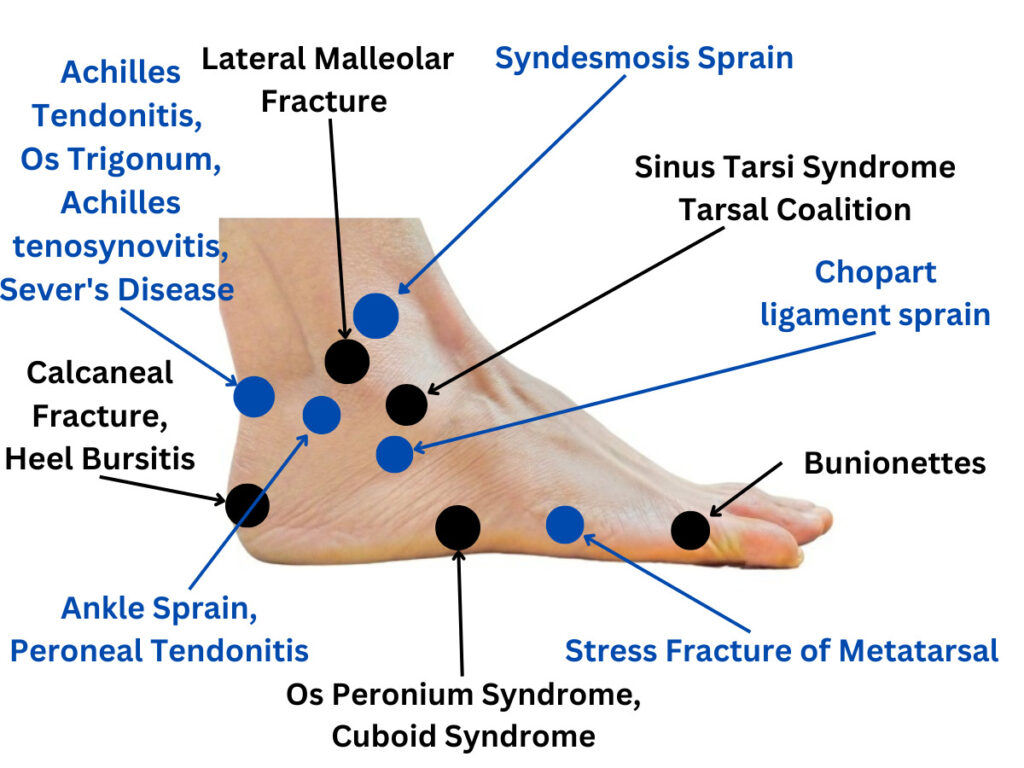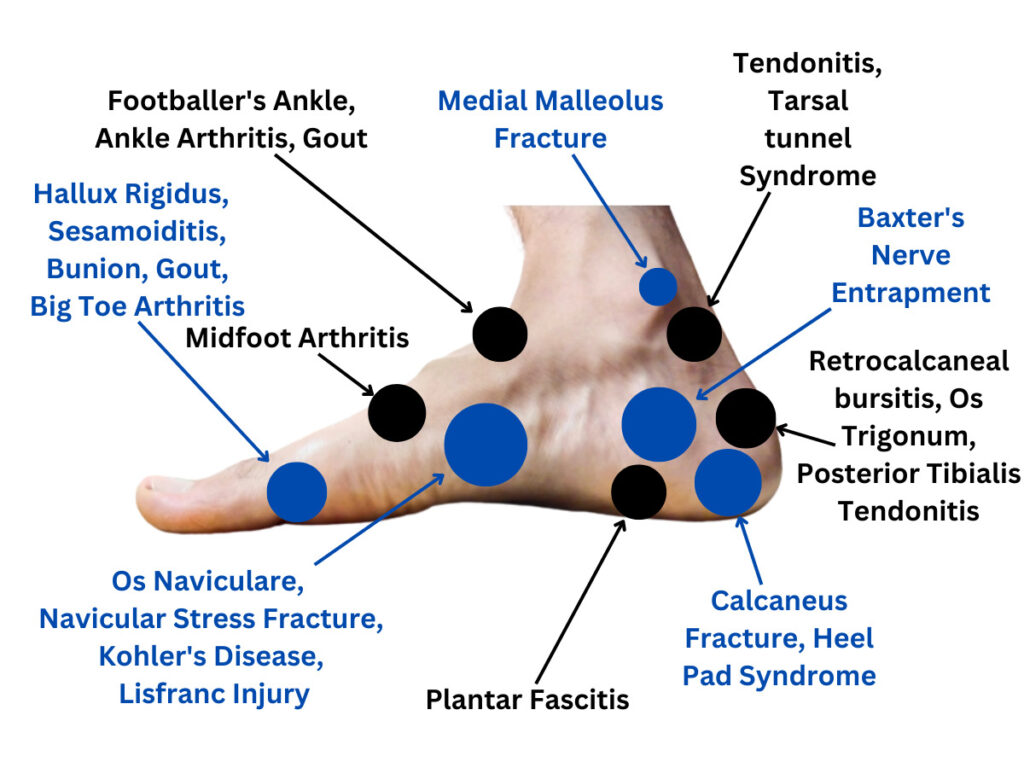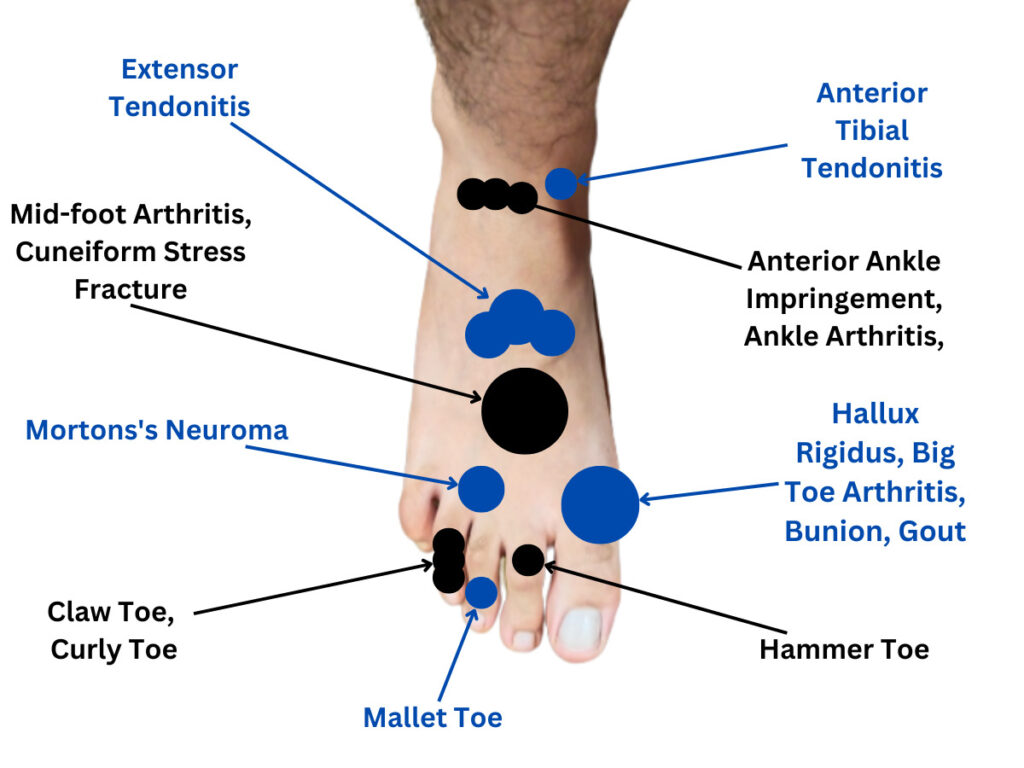What is Foot Pain?
Foot pain is a common complaint for people of all ages, and can be caused by various conditions. Foot pain can range from mild discomfort to severe pain that affects everyday activities. You can locate your type of foot pain in the foot pain chart given below.
The most common causes of foot pain include overuse injuries such as plantar fasciitis, stress fractures, tendonitis, and bunions; medical conditions such as arthritis and gout; or structural issues such as flat feet or high arches.
To diagnose the cause of your foot pain, it’s essential first to understand where the pain is located and what type of pain it is. To help you better identify the source of your pain, we have provided foot pain charts below showing the most common areas of foot pain and their associated causes.
Foot Pain Chart
Side Foot Pain Chart
Outer Side Foot Pain Chart

Inside Foot Pain Chart

Top Foot Pain Chart
top foot pain diagnosis chart
top of foot pain chart

Bottom Foot Pain Chart
foot pain chart bottom, bottom of foot pain chart, under foot pain chart
You Can Find More Charts Here(James-Mccormack) and Here(Dr. Lorenzi Masci)
Diagnosing Your Foot Pain with a Chart
foot pain chart diagnosis, foot pain diagnosis chart
When diagnosing your foot pain or ankle pain, referring to a foot pain chart can be helpful. This type of chart classifies different types of foot pain and the possible causes. It is essential to keep in mind that these charts are not meant to provide a definitive diagnosis – they are intended only as guidelines for further evaluations by a medical professional.
Types of Foot Pain
Foot pain can be quite severe making it difficult to perform everyday activities like standing, walking, and running. Thankfully, there are a variety of treatments available to alleviate foot pain and help you get back on your feet. To better understand the cause of your foot pain, it’s important to be aware of the different types of foot pain that may affect you.
Plantar Fasciitis:
Plantar fasciitis is an inflammation of the plantar fascia. It is a band of tissue that connects the heel bone to the toes and helps support the arch of your foot. Common symptoms include arch pain or heel of the foot upon standing or walking, and can often worsen after long periods of sitting.
Tendonitis:
Tendonitis is an inflammation of the tendons, which connect muscles to bones. Most commonly affecting the Achilles tendon, this condition can cause pain and tenderness in the back of the heel.
Stress Fractures:
Stress fractures are tiny cracks in a bone that occur due to repetitive stress or overuse of a particular area of the foot. Symptoms can include swelling, bruising, and pain that increases with activity.
Arthritis:
Arthritis is a joint disorder that causes inflammation and pain in the joints. Symptoms can include swelling, stiffness, redness, and pain when you move or apply pressure to the affected area.
Bunions:
Bunions are bony bumps on the side of the big toe that cause irritation and can lead to other foot problems such as hammertoes and corns. Symptoms include bunion pain, redness, tenderness, and a visible bump on the side of the big toe.
Flat Feet:
Flat feet are a condition in which the arch of your foot collapses, resulting in reduced shock absorption in the feet. Common symptoms include pain in the feet or ankles when standing or walking for long periods of time.
High Arches:
High arches, also known as cavus foot, is a condition in which the arch of your foot is higher than normal. People with high arches may experience pain and discomfort when standing or walking for long periods of time. In some cases, they may also be more prone to ankle sprains due to decreased stability in the feet. Additionally, pressure points can form as a result of the increased pressure on certain parts of the foot.
Causes of Foot Pain
Foot pain can be caused by a variety of factors, such as injuries, excessive wear, and tear due to overuse, or long periods of standing or walking. Some causes of joint foot pain include:
Plantar Fasciitis:
This condition occurs when the plantar fascia (a band of soft tissue that runs along the bottom of your foot) becomes inflamed and causes pain in the heel and arch of your foot.
Tendonitis:
This condition occurs when the tendons in your feet become irritated or inflamed, causing pain in the back of your heel.
Stress Fractures:
These cracks in a bone occur due to repetitive stress or overuse of a particular area of your foot and may cause severe pain when standing or walking for long periods of time. The fifth metatarsal is the most commonly fractured metatarsal and of the tarsal bones calcaneus is most commonly fractured.
Arthritis:
It can be rheumatoid arthritis or any other type. This joint disorder can cause inflammation and pain in the joints of your feet. When you move or apply pressure to the affected area, it leads to stiffness and redness. Uric acid crystals also build up in gouty arthritis causing painful conditions.
Bunions:
These bony bumps a deformity on the side of the big toe may cause irritation and lead to other foot problems like hammertoes and corns. They are often characterized by pain called bunion pain, redness, tenderness, and a visible bump on the side of the big toe.
Flat Feet:
When the arch of your foot collapses, it can lead to reduced shock absorption in your feet and cause pain when standing or walking for long periods of time.
High Arches:
This condition occurs when the arch in your foot is higher than normal. People with high arches may experience pain and discomfort when standing or walking for long periods of time, as well as increased pressure on certain parts of the foot that can result in pressure points.
Metatarsalgia:
Metatarsalgia is a common type of foot pain that occurs in the forefoot, usually at the base of the toes. Symptoms may include sharp pains, burning sensations, or numbness in the affected area.
Morton’s Neuroma:
Morton’s neuroma is a condition in which the nerve between the third and fourth toes becomes swollen, causing sharp pain in the ball of the foot. This pain may worsen when walking or wearing tight shoes.
Heel Spurs:
Heel spurs are calcium deposits formed causing bone growth on the heel bone that can cause pain and discomfort when walking or standing. They often develop as a result of tight calf muscles, improper shoe fit, or long periods of time standing on hard surfaces. symptoms include sharp pains in the heel area and tenderness when applying pressure to the affected area.
Neuromas:
Neuromas are thickened nerve tissue that can cause pain, burning, or numbness in the ball of your foot. Wearing ill-fitting shoes or putting too much pressure on the forefoot may cause them.
Sesamoiditis:
Sesamoiditis is an inflammation of the sesamoids (two small bones located underneath the first metatarsal bone in the foot) that can cause pain and tenderness in the ball of your foot. Repetitive activities such as running or jumping often cause it.
Sever’s Disease:
Sever’s disease is a condition that affects children and adolescents, causing heel pain due to inflammation in the heel bone. Symptoms may include swelling, tenderness, and pain when pressure is applied to the affected area.
Hallux Rigidus:
Hallux rigidus is a condition that occurs when the big toe joint becomes stiff and painful due to arthritis. Symptoms may include difficulty bending the toe, pain when walking or standing for long periods of time, and redness or swelling in the affected area.
Metatarsalgia Sesamoidea:
Metatarsalgia sesamoidea occurs when the sesamoids (small bones underneath the first metatarsal bone) become inflamed, leading to pain in the ball of your foot. Wearing ill-fitting shoes or putting too much pressure on the forefoot causes it.
Hammertoe:
Hammertoe is a condition in which one or more of the toes become contracted at the middle joints and end joints, resulting in a distorted, claw-like shape. Tight shoes or sports like running or tennis often cause it.
Heel Bursitis:
Heel bursitis is an inflammation of the fluid-filled sacs that act as cushions between bones and tendons. It can cause pain in the heel area when walking or standing for long periods of time. Symptoms may include swelling, redness, tenderness, and a visible lump near your heel.
Achilles Tendinitis:
Achilles tendinitis is an inflammation of the Achilles tendon, located at the back of your ankle. It can cause pain and stiffness in the heel and calf area that worsens with activity. Other symptoms may include swelling, tenderness, and difficulty walking.
Tarsal Tunnel Syndrome:
Tarsal tunnel syndrome occurs when a nerve in your foot becomes compressed, leading to pain, numbness, and tingling in the affected area. It is often caused by wearing tight shoes or playing sports such as running or tennis.
Who Experiences Foot Pain?
Foot pain is a common issue that can affect people of all ages. It can range from mild discomfort to severe pain, and there are a variety of causes. Some of the most common causes of foot and ankle pain include overuse injuries, biomechanical problems, and systemic diseases. Here are some groups of individuals who might experience foot pain:
1. Runners and Other Athletes:
Overuse injuries are common among athletes, especially those who participate in sports and physical activities that involve repetitive motions such as running. Runners are particularly susceptible to conditions such as plantar fasciitis, tendonitis, stress fractures, ankle injury, and bunions.
2. People with Arthritis:
People affected by arthritis may experience foot pain due to inflammation and stiffness in the joints of the feet. Additionally, people with certain systemic diseases such as diabetes may be more prone to foot pain.
3. People Who Wear Improperly Fitting Shoes:
Wearing shoes that do not fit properly can cause a variety of foot issues, including bunions and stress fractures, and skin irritation. It’s important to wear shoes that provide support and have the correct size and shape for your feet to avoid irritation of the skin and foot joints of the body.
4. People with High Arches or Flat Feet:
People with high arches may experience more foot pain due to the increased amount of pressure placed on certain parts of the feet. Similarly, people with flat feet may experience an imbalance in the distribution of weight on their feet, leading to pain.
5. Older Adults:
As we age, our feet can become more prone to injury and pain due to changes in the structure or biomechanics of the feet. Additionally, older adults may have a harder time recovering from foot injuries and may need more time to heal.
Conclusion
Foot pain is a common issue that can affect people of all ages and athletic abilities. The causes of foot pain range from overuse injuries to systemic diseases, so it’s important to speak with a healthcare provider if you are experiencing persistent pain. Additionally, wearing properly fitting shoes and practicing good foot care can help reduce your risk of developing foot pain.
Treatment of Foot Pain
Foot pain can be caused by a variety of conditions, ranging from minor issues like mild foot pain to more serious medical problems. Treatment options vary depending on the underlying cause and medical history. In general, however, treatment for foot pain typically begins with rest, physical therapy, ice or heat therapy, and over-the-counter medication drugs to reduce inflammation and manage discomfort.
In some cases, foot pain may require more invasive treatments such as steroid injections, medications, or surgery. Orthotics can also be used to help redistribute the weight on your feet and provide additional support to reduce stress and strain. Massage therapy can also be beneficial in relieving tension and providing relief from pain.
If your foot pain is due to an injury, it’s important to follow the RICE protocol (rest, ice, compression, and elevation). Additionally, you should avoid activities that cause strain or discomfort and wear supportive footwear. If your foot pain persists despite these measures, speak with a doctor for further evaluation.

This is an excellent chart with easy-to-use accompanying information. Thanks Hadid! Very well done.